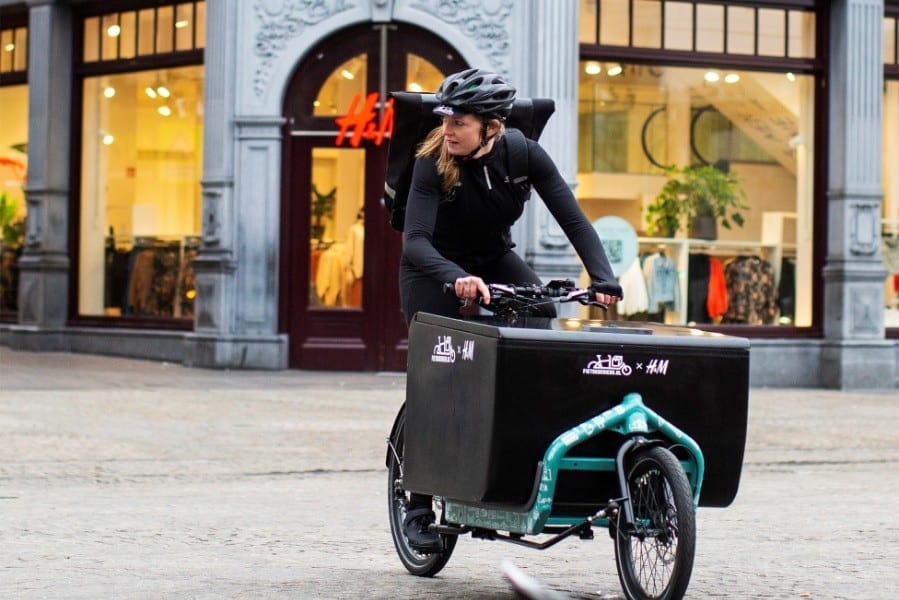Retailers are working with suppliers to help them reach sustainability targets. We report on two new examples.
M&S: shift to bio-gas
M&S logistics partner DHL Supply Chain is replacing diesel trucks with more sustainable alternatives.
By 2025, DHL aims to have more than 500 gas-powered vehicles in its fleet. It has just taken delivery of 20 new bio-LNG trucks from Volvo – each replacing a diesel truck – on top of 13 that arrived in January. The new vehicles alone are expected to contribute an 80% reduction in annual carbon emissions, equivalent to 2,200 tonnes of carbon. DHL provides warehousing and transport support for M&S Clothing and Home and the new trucks will be used in the M&S fleet at Peterborough, Swindon and Castle Donington.
Tim Greenwood, head of transport at Marks & Spencer, says: “We are committed to reducing our environmental impact in line with our Plan A sustainability action plan. It’s important to us that our partners’ values and ambitions align with ours and that’s one of the reasons we have a long-standing relationship with DHL. Replacing diesel trucks for brand new bio-LNG vehicles is a good step forward in reducing our carbon emissions.”
The step also contributes to DHL’s GoGreen plan. By 2050, the company aims to increase its carbon efficiency by 50% compared to 2007 levels.
Gavin Murdoch, MD transport at DHL Supply Chain, says: “As an industry leader, we have a responsibility to demonstrate innovation and initiative by providing sustainable solutions for our customers. Employing alternative fuel vehicles is an important part of our GoGreen mission and net zero ambition, and bio-LNG is a cleaner and more sustainable option to significantly reduce carbon emissions.”
H&M and Bestseller: moving to organic cotton
Organic Cotton Accelerator (OCA) says the number of cotton farmers moving to organic and joining its programme is growing quickly as demand from retailers rises. The group of industry partners focused on organic cotton says that the number of farmers in its farm programme grew by 180% last year, with each farmer making higher profits as a result. Farmers on average earned 21% more in net profit from their cotton per hectare then local non-organic farmers. In its current 2021/22 year it says it is working with almost 80,000 organic cotton farmers – more than 260% up from the more than 22,000 it worked with a year earlier.
The move comes as more retailers move to use organic cotton in their clothing. Danish fashion retailer Bestseller has set a target of sourcing 30% more organic cotton by 2025.
Danique Lodewijk, senior project specialist at Bestseller, says: “Organic cotton plays an integral role in developing a more sustainable fashion industry. Partnering with OCA helps us reach our target of sourcing 30% organic cotton by 2025. We’re proud to help OCA develop a transparent, responsible and resilient organic cotton supply chain that also transforms farming communities and promotes biodiversity.”
H&M Group, meanwhile, is now using cotton that is in conversion to organic in its portfolio fo sustainable materials. By doing so it aims to support farmers through transition and help them to build capacity more quickly.
Hitesh Sharma, material programme manager for cotton at fashion retailer H&M Group, says: “As one of the largest consumers of organic cotton, it’s important for the H&M Group to invest in the development of the organic cotton sector. As a founding member of OCA, we’ve been working together to build a sustainable organic cotton supply and financially support cotton farmers. Since our first farm project with OCA in 2017, we have continued to scale the volumes we source through the OCA Farm Programme every year. The partners and farmers involved in these projects have continued to engage with us on this journey, demonstrating the commitment required from all parties if we are to realise the future of the organic cotton sector.”
Bart Vollaard, executive director at OCA, says: “Organic cotton holds the key to a more sustainable fashion system and we see demand getting stronger. More farmers are switching to organic farming and more global brands and retailers are expanding their organic cotton sourcing and investing the support required for farmers to grow organic successfully.
“That is good news for farmers and for the planet, but switching to organic cotton is a long haul. It takes up to three years for farmers to convert to organic cotton farming, a necessary period to build up the soil fertility and re-establish the balance of the ecosystem and farmers must be supported during this time – which is one of the key roles that OCA plays.”
OCA says cotton accounted for a quarter of total global textile fibre production in 2019, but 99% of cotton is currently produced under non-organic methods. It says conventional methods contribute to climate change by releasing nitrous oxide, which it says has 300 times the warning effect of carbon dioxide. It has a 2030 strategy aimed at moving towards organic cotton.









